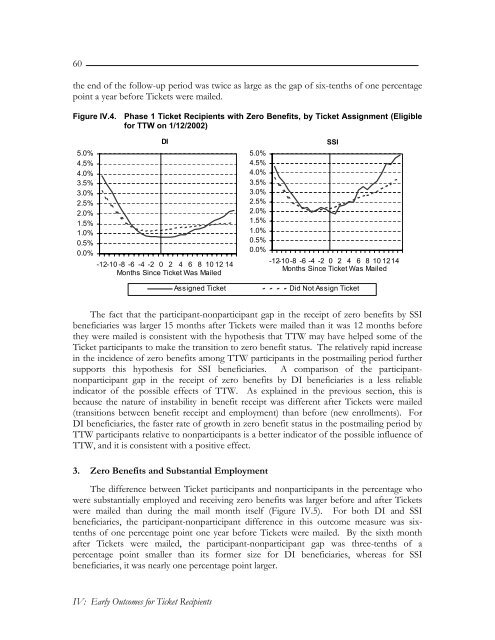Evaluation of the Ticket to Work Program, Implementation ...
Evaluation of the Ticket to Work Program, Implementation ...
Evaluation of the Ticket to Work Program, Implementation ...
Create successful ePaper yourself
Turn your PDF publications into a flip-book with our unique Google optimized e-Paper software.
60<strong>the</strong> end <strong>of</strong> <strong>the</strong> follow-up period was twice as large as <strong>the</strong> gap <strong>of</strong> six-tenths <strong>of</strong> one percentagepoint a year before <strong>Ticket</strong>s were mailed.Figure IV.4. Phase 1 <strong>Ticket</strong> Recipients with Zero Benefits, by <strong>Ticket</strong> Assignment (Eligiblefor TTW on 1/12/2002)5.0%4.5%4.0%3.5%3.0%2.5%2.0%1.5%1.0%0.5%0.0%DI-12-10 -8 -6 -4 -2 0 2 4 6 8 10 12 14Months Since <strong>Ticket</strong> Was MailedAssigned <strong>Ticket</strong>SSI5.0%4.5%4.0%3.5%3.0%2.5%2.0%1.5%1.0%0.5%0.0%-12-10-8 -6 -4 -2 0 2 4 6 8 10 1214Months Since <strong>Ticket</strong> Was MailedDid Not Assign <strong>Ticket</strong>The fact that <strong>the</strong> participant-nonparticipant gap in <strong>the</strong> receipt <strong>of</strong> zero benefits by SSIbeneficiaries was larger 15 months after <strong>Ticket</strong>s were mailed than it was 12 months before<strong>the</strong>y were mailed is consistent with <strong>the</strong> hypo<strong>the</strong>sis that TTW may have helped some <strong>of</strong> <strong>the</strong><strong>Ticket</strong> participants <strong>to</strong> make <strong>the</strong> transition <strong>to</strong> zero benefit status. The relatively rapid increasein <strong>the</strong> incidence <strong>of</strong> zero benefits among TTW participants in <strong>the</strong> postmailing period fur<strong>the</strong>rsupports this hypo<strong>the</strong>sis for SSI beneficiaries. A comparison <strong>of</strong> <strong>the</strong> participantnonparticipantgap in <strong>the</strong> receipt <strong>of</strong> zero benefits by DI beneficiaries is a less reliableindica<strong>to</strong>r <strong>of</strong> <strong>the</strong> possible effects <strong>of</strong> TTW. As explained in <strong>the</strong> previous section, this isbecause <strong>the</strong> nature <strong>of</strong> instability in benefit receipt was different after <strong>Ticket</strong>s were mailed(transitions between benefit receipt and employment) than before (new enrollments). ForDI beneficiaries, <strong>the</strong> faster rate <strong>of</strong> growth in zero benefit status in <strong>the</strong> postmailing period byTTW participants relative <strong>to</strong> nonparticipants is a better indica<strong>to</strong>r <strong>of</strong> <strong>the</strong> possible influence <strong>of</strong>TTW, and it is consistent with a positive effect.3. Zero Benefits and Substantial EmploymentThe difference between <strong>Ticket</strong> participants and nonparticipants in <strong>the</strong> percentage whowere substantially employed and receiving zero benefits was larger before and after <strong>Ticket</strong>swere mailed than during <strong>the</strong> mail month itself (Figure IV.5). For both DI and SSIbeneficiaries, <strong>the</strong> participant-nonparticipant difference in this outcome measure was sixtenths<strong>of</strong> one percentage point one year before <strong>Ticket</strong>s were mailed. By <strong>the</strong> sixth monthafter <strong>Ticket</strong>s were mailed, <strong>the</strong> participant-nonparticipant gap was three-tenths <strong>of</strong> apercentage point smaller than its former size for DI beneficiaries, whereas for SSIbeneficiaries, it was nearly one percentage point larger.IV: Early Outcomes for <strong>Ticket</strong> Recipients
















